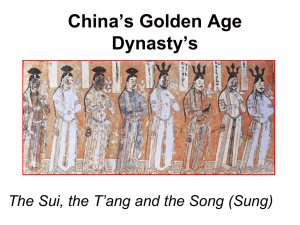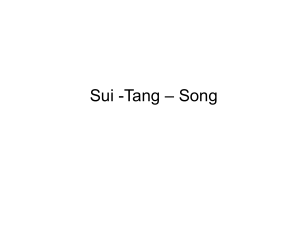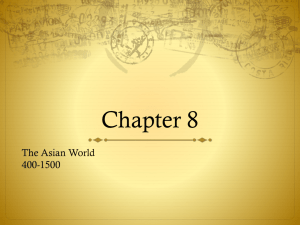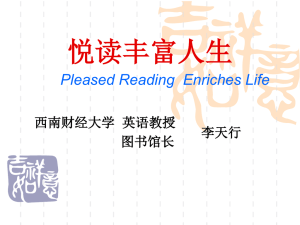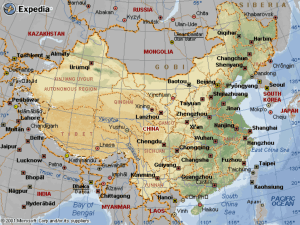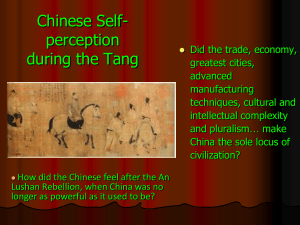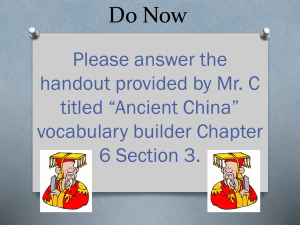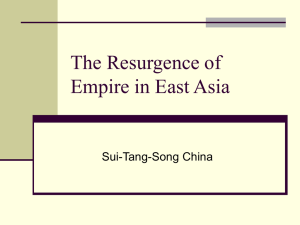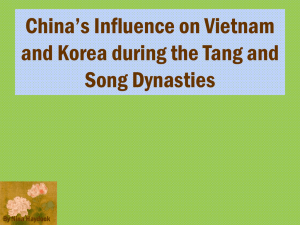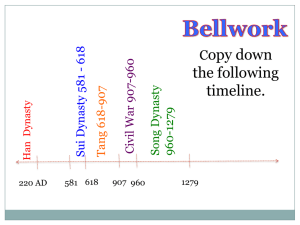WHAP * Duez Unit 3 AN AGE OF ACCELERATING CONNECTIONS
advertisement
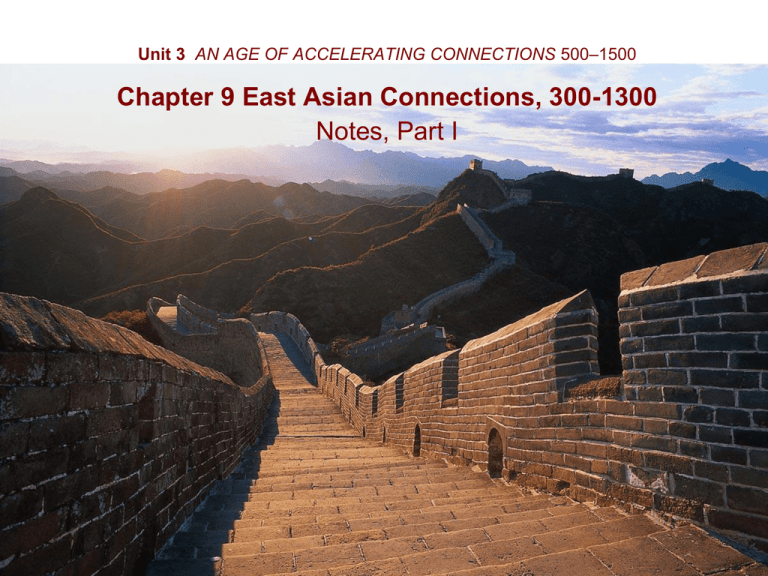
Unit 3 AN AGE OF ACCELERATING CONNECTIONS 500–1500 Chapter 9 East Asian Connections, 300-1300 Notes, Part I The Han Dynasty 202 BCE – 220 CE • Lui Bang (LYOH BONG) – a man of peasant origin who became the emperor. He came to be known as Han Gaozu (“Exalted Emperor of Han”) • Confucian principals rather than legalism were favored. • Continued the same type of government system developed by the Qin. The Han dynasty collapsed around 220 C.E. 1. led to 300 years of political fragmentation 2. nomadic incursion from the north 3. conditions discredited Confucianism in many eyes 4. Chinese migration southward to Yangzi River valley began And, How did the Chinese and their nomadic neighbors to the north view each other? Big Picture Questions 1. In what ways did Tang and Song dynasty China resemble the classical Han dynasty period, and in what ways had China changed? • Tang and Song dynasty China resembled the Han dynasty period in a number of ways, including the maintenance of the imperial political system, and the importance of a professional bureaucracy formally trained and subject to competitive exams. • Also similar was a focus on establishing a dominant political position in East Asia that was recognized by China’s neighbors; an interest in and support for long-distance trade; and the continued importance of the Confucian tradition in elite society. 1. In what ways did Tang and Song dynasty China resemble the classical Han dynasty period, and in what ways had China changed? • Tighter unification of northern and southern China through a vast waterway system; the longterm migration of Chinese populations south into the Yangzi River valley after 220 c.e.; and an economic revolution that made it the richest empire on earth. • There was rapid population growth, from 50 million to 60 million people during the Tang, which was spurred in part by a remarkable growth in agricultural production. • The economy of China became the most highly commercialized in the world and became more active in long-distance trade than during the Han dynasty. Why are the centuries of the Tang and Song dynasties in China sometimes referred to as a “golden age”? 1. Sui dynasty (589–618) reunified China a. Sui rulers vastly extended the canal system b. but their ruthlessness and failure to conquer Korea alienated people, exhausted state’s resources c. dynasty was overthrown, but state didn’t disintegrate 2. Tang (618–907) and Song (960–1279) dynasties built on Sui foundations a. established patterns of Chinese life that lasted into 20th century b. regarded as a golden age of arts and literature “Golden Age” Map 9.1 Tang and Song Dynasty China During the postclassical millennium, China interacted extensively with its neighbors. The Tang dynasty extended Chinese control deep into Central Asia, while the Song dynasty witnessed incursions by the nomadic Jurchen people, who created the Jin Empire, which ruled parts of northern China. Notice the great canal that links both the Yellow and Yangzi Rivers. Why are the centuries of the Tang and Song dynasties in China sometimes referred to as a “golden age”? Also, In what ways did women’s lives change during the Tang and Song dynasties? Song Era wasn’t very “golden” for women In the visual source, An Elite Night Party, women are depicted as entertainers and temptresses. • During the Tang dynasty, elite women in the north had had greater freedom (influence of steppe nomads) • Song: tightening of patriarchal restrictions on women • Textile production became larger scale, displacing women from their traditional role in the industry • Women found other roles in cities: prosperity of the elite created demand for concubines, entertainers, courtesans, prostitutes Foot Binding • literature highlighted the subjection of women • foot binding started in 10th or 11th century C.E. • was associated with images of female beauty and eroticism • kept women restricted to the house Some positive trends for women during Song • Although the Song Dynasty returned to Confucian ways: • women's property rights expanded • and lower-ranking but ambitious officials strongly urged the education of women, so that they might more effectively raise their sons and increase the family’s fortune. The term martial arts refers to arts of combat and self-defense. • They are a significant part of Asian history and culture. • Chinese martial arts were highly visible already during the Han dynasty. • Later, in 495, a Zen Buddhist monastery began developing methods of physical training known today as kung fu. • In the Tang Dynasty, descriptions of sword dances were immortalized in poems by Li Bai. In the Song Dynasty, xiangpu contests were sponsored by the imperial courts. The modern concepts of wushu (kung fu) were fully developed by the Ming Dynasty.

